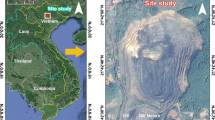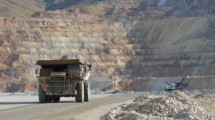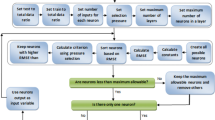Abstract
Ground vibration (PPV) is one of the hazard effects induced by blasting operations in open-pit mines, which can affect the surrounding structures, particularly the stability of benches and slopes in open-pit mines, and impact underground water, railway, highway, and puzzling for neighboring communities. Therefore, controlling, accurate prediction, and mitigating blast-induced PPV are necessary. This study contributed a new computational model in predicting blast-induced PPV for the science community and practical engineering with high accuracy level. In this study, a novel hybrid artificial intelligence model based on the hierarchical k-means clustering algorithm (HKM) and artificial neural network (ANN), namely a HKM–ANN model, was considered and proposed for predicting blast-caused PPV in open-pit mines. Accordingly, input data were first clustered by the HKM algorithm, and then, the ANN models were developed based on the obtained clusters. For this aim, 185 blasting events were collected and analyzed. A hybrid model based on fuzzy c-means clustering (FCM) and support vector regression (SVR), i.e., FCM–SVR model, which was proposed by previous authors was also applied for comparison of results with our proposed HKM–ANN model. In addition, an empirical method, several ANN and SVR models (without clustering), FCM–ANN, and HKM–SVR were developed for comparison purposes. For measuring the performance of the improved models, coefficient determination (R2), root-mean-square error, and variance account for were used as the performance indicators. The results show that the HKM algorithm played a significant role in improving the accuracy of the ANN models. The proposed HKM–ANN model was the most superior model in estimating PPV caused by blasting operations in this study.














Similar content being viewed by others
References
Abbas, A. S., & Asheghi, R. (2018). Optimized developed artificial neural network-based models to predict the blast-induced ground vibration. Innovative Infrastructure Solutions,3, 1–10.
Ak, H., & Konuk, A. (2008). The effect of discontinuity frequency on ground vibrations produced from bench blasting: A case study. Soil Dynamics and Earthquake Engineering,28(9), 686–694.
Ambraseys, N. R., & Hendron, A. J. (1968). Dynamic behavior of rock masses. In K. G. Stagg & O. C. Zienkievicz (Eds.), Rock mechanics in engineering practice (pp. 203–207). London: John Wiley and Sons.
Amiri, M., Amnieh, H. B., Hasanipanah, M., & Khanli, L. M. (2016). A new combination of artificial neural network and k-nearest neighbors models to predict blast-induced ground vibration and air-overpressure. Engineering with Computers,32(4), 631–644.
Arai, K., & Barakbah, A. R. (2007). Hierarchical k-means: An algorithm for centroids initialization for k-means. Reports of the Faculty of Science and Engineering,36(1), 25–31.
Armaghani, D. J., Hajihassani, M., Mohamad, E. T., Marto, A., & Noorani, S. (2014). Blasting-induced flyrock and ground vibration prediction through an expert artificial neural network based on particle swarm optimization. Arabian Journal of Geosciences,7(12), 5383–5396.
Armaghani, D. J., Hasanipanah, M., Amnieh, H. B., & Mohamad, E. T. (2018). Feasibility of ICA in approximating ground vibration resulting from mine blasting. Neural Computing and Applications,29(9), 457–465.
Armaghani, D. J., Mohamad, E. T., Momeni, E., Monjezi, M., & Narayanasamy, M. S. (2016). Prediction of the strength and elasticity modulus of granite through an expert artificial neural network. Arabian Journal of Geosciences,9(1), 48.
Armaghani, D. J., Mohamad, E. T., Narayanasamy, M. S., Narita, N., & Yagiz, S. (2017). Development of hybrid intelligent models for predicting TBM penetration rate in hard rock condition. Tunnelling and Underground Space Technology,63, 29–43.
Ataei, M., & Osanloo, M. (2004). Using a combination of genetic algorithm and the grid search method to determine optimum cutoff grades of multiple metal deposits. International Journal of Surface Mining, Reclamation, and Environment,18(1), 60–78.
Banerjee, A., & Dave, R. N. (2004) Validating clusters using the Hopkins statistic. In 2004 IEEE international conference on fuzzy systems, 2004. Proceedings (Vol. 1, pp. 149–153). IEEE.
Behzadafshar, K., Mohebbi, F., Soltani Tehrani, M., Hasanipanah, M., & Tabrizi, O. (2018). Predicting the ground vibration induced by mine blasting using imperialist competitive algorithm. Engineering Computations,35(4), 1774–1787.
Bezdek, J. C., & Hathaway, R. J. (2002). VAT: A tool for visual assessment of (cluster) tendency. In Proceedings of the 2002 international joint conference on neural networks, 2002. IJCNN’02 (Vol. 3, pp. 2225–2230). IEEE.
Bholowalia, P., & Kumar, A. (2014). EBK-means: A clustering technique based on elbow method and k-means in WSN. International Journal of Computer Applications, 105(9).
Brown, W., Groves, D., & Gedeon, T. (2003). Use of fuzzy membership input layers to combine subjective geological knowledge and empirical data in a neural network method for mineral-potential mapping. Natural Resources Research,12(3), 183–200.
Bui, D. T., Tuan, T. A., Klempe, H., Pradhan, B., & Revhaug, I. (2016). Spatial prediction models for shallow landslide hazards: A comparative assessment of the efficacy of support vector machines, artificial neural networks, kernel logistic regression, and logistic model tree. Landslides,13(2), 361–378.
Bui, X. N., Nguyen, H., Le, H. A., Bui, H. B., & Do, N. H. (2019). Prediction of blast-induced air over-pressure in open-pit mine: Assessment of different artificial intelligence techniques. Natural Resources Research. https://doi.org/10.1007/s11053-019-09461-0.
Burrascano, P., Fiori, S., & Mongiardo, M. (1999). A review of artificial neural networks applications in microwave computer-aided design (invited article). International Journal of RF and Microwave Computer-Aided Engineering,9(3), 158–174.
Buscema, P. M., Massini, G., Breda, M., Lodwick, W. A., Newman, F., & Asadi-Zeydabadi, M. (2018). Artificial adaptive systems using auto contractive maps: Theory, applications and extensions (Vol. 131). Berlin: Springer.
Carranza, E. J. M. (2017). Natural resources research publications on geochemical anomaly and mineral potential mapping, and introduction to the special issue of papers in these fields. Natural Resources Research,26(4), 379–410.
Chandar, K. R., Sastry, V., & Hegde, C. (2017). A critical comparison of regression models and artificial neural networks to predict ground vibrations. Geotechnical and Geological Engineering,35(2), 573–583.
Duvall, W. I., & Petkof, B. (1958). Spherical propagation of explosion-generated strain pulses in rock. Washington, DC: Bureau of Mines.
Faradonbeh, R. S., Armaghani, D. J., Majid, M. A., Tahir, M. M., Murlidhar, B. R., Monjezi, M., et al. (2016). Prediction of ground vibration due to quarry blasting based on gene expression programming: A new model for peak particle velocity prediction. International Journal of Environmental Science and Technology,13(6), 1453–1464.
Faradonbeh, R. S., & Monjezi, M. (2017a). Prediction and minimization of blast-induced ground vibration using two robust meta-heuristic algorithms. Engineering with Computers,33(4), 835–851.
Faradonbeh, R. S., & Monjezi, M. (2017b). Prediction and minimization of blast-induced ground vibration using two robust meta-heuristic algorithms. Engineering with Computers,33, 1–17.
Fişne, A., Kuzu, C., & Hüdaverdi, T. (2011). Prediction of environmental impacts of quarry blasting operation using fuzzy logic. Environmental Monitoring and Assessment,174(1–4), 461–470.
Gao, W., Dimitrov, D., & Abdo, H. (2018a). Tight independent set neighborhood union condition for fractional critical deleted graphs and ID deleted graphs. Discrete & Continuous Dynamical Systems-S. https://doi.org/10.3934/dcdss.2019045.
Gao, W., Guirao, J. L., Basavanagoud, B., & Wu, J. (2018b). Partial multi-dividing ontology learning algorithm. Information Sciences,467, 35–58.
Gao, W., Guirao, J. L. G., Abdel-Aty, M., & Xi, W. (2018c). An independent set degree condition for fractional critical deleted graphs. Discrete & Continuous Dynamical Systems-S. https://doi.org/10.3934/dcdss.2019058.
Gao, W., Wang, W., Dimitrov, D., & Wang, Y. (2018d). Nano properties analysis via fourth multiplicative ABC indicator calculating. Arabian Journal of Chemistry,11(6), 793–801.
Gao, W., Wu, H., Siddiqui, M. K., & Baig, A. Q. (2018e). Study of biological networks using graph theory. Saudi Journal of Biological Sciences,25(6), 1212–1219.
Gardner, M. W., & Dorling, S. (1998). Artificial neural networks (the multilayer perceptron)—A review of applications in the atmospheric sciences. Atmospheric Environment,32(14–15), 2627–2636.
Ghasemi, E., Kalhori, H., & Bagherpour, R. (2016). A new hybrid ANFIS–PSO model for prediction of peak particle velocity due to bench blasting. Engineering with Computers,32(4), 607–614.
Ghosh, A., & Daemen, J. J. (1983) A simple new blast vibration predictor (based on wave propagation laws). In The 24th US symposium on rock mechanics (USRMS). American Rock Mechanics Association.
Hajihassani, M., Armaghani, D. J., Monjezi, M., Mohamad, E. T., & Marto, A. (2015). Blast-induced air and ground vibration prediction: A particle swarm optimization-based artificial neural network approach. Environmental Earth Sciences,74(4), 2799–2817.
Hasanipanah, M., Amnieh, H. B., Khamesi, H., Armaghani, D. J., Golzar, S. B., & Shahnazar, A. (2018). Prediction of an environmental issue of mine blasting: An imperialistic competitive algorithm-based fuzzy system. International Journal of Environmental Science and Technology,15(3), 551–560. https://doi.org/10.1007/s13762-017-1395-y.
Hasanipanah, M., Faradonbeh, R. S., Amnieh, H. B., Armaghani, D. J., & Monjezi, M. (2017a). Forecasting blast-induced ground vibration developing a CART model. Engineering with Computers,33(2), 307–316.
Hasanipanah, M., Monjezi, M., Shahnazar, A., Armaghani, D. J., & Farazmand, A. (2015). Feasibility of indirect determination of blast induced ground vibration based on support vector machine. Measurement,75, 289–297.
Hasanipanah, M., Naderi, R., Kashir, J., Noorani, S. A., & Qaleh, A. Z. A. (2017b). Prediction of blast-produced ground vibration using particle swarm optimization. Engineering with Computers,33(2), 173–179.
Hustrulid, W. A., Kuchta, M., & Martin, R. K. (2013). Open Pit Mine Planning and Design, Two Volume Set & CD-ROM Pack: V1: Fundamentals, V2: CSMine Software Package, CD-ROM: CS Mine Software. Boca Raton: CRC Press.
Iphar, M., Yavuz, M., & Ak, H. (2008). Prediction of ground vibrations resulting from the blasting operations in an open-pit mine by adaptive neuro-fuzzy inference system. Environmental Geology,56(1), 97–107.
James, G., Witten, D., Hastie, T., & Tibshirani, R. (2013). An introduction to statistical learning (Vol. 112). Berlin: Springer.
Kalogirou, S. A. (2001). Artificial neural networks in renewable energy systems applications: A review. Renewable and Sustainable Energy Reviews,5(4), 373–401.
Kashani, M. H., Ghorbani, M. A., Dinpashoh, Y., & Shahmorad, S. (2014). Comparison of volterra model and artificial neural networks for rainfall–runoff simulation. Natural Resources Research,23(3), 341–354.
Kodinariya, T. M., & Makwana, P. R. (2013). Review on determining number of cluster in k-means clustering. International Journal of Advance Research in Computer Science and Management Studies,1(6), 90–95.
Kumar, R., Choudhury, D., & Bhargava, K. (2016). Determination of blast-induced ground vibration equations for rocks using mechanical and geological properties. Journal of Rock Mechanics and Geotechnical Engineering,8(3), 341–349.
Langefors, U., & Kihlstrom, B. (1963). The modern techniques of rock blasting. New York: Wiley.
Lisboa, P. J., & Taktak, A. F. (2006). The use of artificial neural networks in decision support in cancer: A systematic review. Neural Networks,19(4), 408–415.
MacQueen, J. (1967) Some methods for classification and analysis of multivariate observations. In Proceedings of the fifth Berkeley symposium on mathematical statistics and probability (Vol. 1, pp. 281–297, Vol. 14). Oakland, CA.
Moayed, H., Rashid, A. S. A., Muazu, M. A., Nguyen, H., Bui, X.-N., & Bui, D. T. (2019). Prediction of ultimate bearing capacity through various novel evolutionary and neural network models. Engineering with Computers. https://doi.org/10.1007/s00366-019-00723-2.
Mohamad, E. T., Noorani, S. A., Armaghani, D. J., & Saad, R. (2012). Simulation of blasting induced ground vibration by using artificial neural network. Electronic Journal of Geotechnical Engineering,17, 2571–2584.
Mohammadnejad, M., Gholami, R., Ramezanzadeh, A., & Jalali, M. (2012). Prediction of blast-induced vibrations in limestone quarries using support vector machine. Journal of Vibration and Control,18(9), 1322–1329.
Mokfi, T., Shahnazar, A., Bakhshayeshi, I., Derakhsh, A. M., & Tabrizi, O. (2018). Proposing of a new soft computing-based model to predict peak particle velocity induced by blasting. Engineering with Computers,34, 1–8.
Mokhtari, M., & Behnia, M. (2018). Comparison of LLNF, ANN, and COA-ANN techniques in modeling the uniaxial compressive strength and static Young’s modulus of limestone of the Dalan Formation. Natural Resources Research,28, 1–17.
Monjezi, M., Ahmadi, M., Sheikhan, M., Bahrami, A., & Salimi, A. (2010). Predicting blast-induced ground vibration using various types of neural networks. Soil Dynamics and Earthquake Engineering,30(11), 1233–1236.
Monjezi, M., Ghafurikalajahi, M., & Bahrami, A. (2011). Prediction of blast-induced ground vibration using artificial neural networks. Tunnelling and Underground Space Technology,26(1), 46–50.
Murmu, S., Maheshwari, P., & Verma, H. K. (2018). Empirical and probabilistic analysis of blast-induced ground vibrations. International Journal of Rock Mechanics and Mining Sciences,103, 267–274.
Nguyen, H., & Bui, X.-N. (2018). Predicting blast-induced air overpressure: A robust artificial intelligence system based on artificial neural networks and random forest. Natural Resources Research. https://doi.org/10.1007/s11053-018-9424-1.
Nguyen, H., Bui, X.-N., Bui, H.-B., & Cuong, D. (2019a). Developing a XGBoost model to predict blast-induced peak particle velocity in open cast mine. A case study. Acta Geophysica. https://doi.org/10.1007/s11600-019-00268-4.
Nguyen, H., Bui, X.-N., Bui, H.-B., & Mai, N.-L. (2018a). A comparative study of artificial neural networks in predicting blast-induced air-blast overpressure at Deo Nai open-pit coal mine, Vietnam. Neural Computing and Applications. https://doi.org/10.1007/s00521-018-3717-5.
Nguyen, H., Bui, X.-N., Thanh, N. T., & Anh, N. T. (2018b). Effectiveness comparison between linear regression and non-linear regression algorithms in predicting blast-induced ground vibration in Nui Beo open-pit coal mine—Quang Ninh. Journal of Mining Industry,02, 78–84.
Nguyen, H., Bui, X.-N., Tran, Q.-H., & Mai, N.-L. (2019b). A new soft computing model for estimating and controlling blast-produced ground vibration based on hierarchical k-means clustering and cubist algorithms. Applied Soft Computing. https://doi.org/10.1016/j.asoc.2019.01.042.
Nick, N. (2008). Joseph Juran, 103, pioneer in quality control, dies. New York Times,3, 3.
Oh, H.-J., & Lee, S. (2010). Application of artificial neural network for gold–silver deposits potential mapping: A case study of Korea. Natural Resources Research,19(2), 103–124.
Oswald, G. L. (1984). Electronic delay blasting circuit. Google Patents.
Prashanth, R., & Nimaje, D. (2018). Estimation of ambiguous blast-induced ground vibration using intelligent models: A case study. Noise & Vibration Worldwide,49(4), 147–157.
Roshanravan, B., Aghajani, H., Yousefi, M., & Kreuzer, O. (2018). Particle swarm optimization algorithm for neuro-fuzzy prospectivity analysis using continuously weighted spatial exploration data. Natural Resources Research, 1–17.
Roy, P. P. (1991). Vibration control in an opencast mine based on improved blast vibration predictors. Mining Science and Technology,12(2), 157–165.
Saadat, M., Khandelwal, M., & Monjezi, M. (2014). An ANN-based approach to predict blast-induced ground vibration of Gol-E-Gohar iron ore mine, Iran. Journal of Rock Mechanics and Geotechnical Engineering,6(1), 67–76.
Samareh, H., Khoshrou, S. H., Shahriar, K., Ebadzadeh, M. M., & Eslami, M. (2017). Optimization of a nonlinear model for predicting the ground vibration using the combinational particle swarm optimization-genetic algorithm. Journal of African Earth Sciences,133, 36–45.
Shahnazar, A., Rad, H. N., Hasanipanah, M., Tahir, M., Armaghani, D. J., & Ghoroqi, M. (2017). A new developed approach for the prediction of ground vibration using a hybrid PSO-optimized ANFIS-based model. Environmental Earth Sciences,76(15), 527.
Sheykhi, H., Bagherpour, R., Ghasemi, E., & Kalhori, H. (2018). Forecasting ground vibration due to rock blasting: A hybrid intelligent approach using support vector regression and fuzzy c-means clustering. Engineering with Computers,34(2), 357–365.
Simangunsong, G. M., & Wahyudi, S. (2015). Effect of bedding plane on prediction blast-induced ground vibration in open pit coal mines. International Journal of Rock Mechanics and Mining Sciences,79, 1–8.
Singer, D. A., & Kouda, R. (2003). Typing mineral deposits using their grades and tonnages in an artificial neural network. Natural Resources Research,12(3), 201–208.
Singh, T., & Singh, V. (2005). An intelligent approach to prediction and control ground vibration in mines. Geotechnical and Geological Engineering,23(3), 249–262.
Swingler, K. (1996). Applying neural networks: A practical guide. Los Altos, CA: Morgan Kaufmann.
Tessema, A. (2017). Mineral systems analysis and artificial neural network modeling of chromite prospectivity in the Western Limb of the Bushveld Complex, South Africa. Natural Resources Research,26(4), 465–488.
Thorndike, R. L. (1953). Who belongs in the family? Psychometrika,18(4), 267–276.
Wagstaff, K., Cardie, C., Rogers, S., & Schrödl, S. (2001) Constrained k-means clustering with background knowledge. In ICML (Vol. 1, pp. 577–584).
Yegnanarayana, B. (2009). Artificial neural networks. New DelhI: PHI Learning Pvt. Ltd.
Acknowledgment
This research was supported by Hanoi University of Mining and Geology (HUMG); Ministry of Education and Training of Vietnam (MOET), and the Center for Mining, Electro-Mechanical research of HUMG.
Author information
Authors and Affiliations
Corresponding authors
Rights and permissions
About this article
Cite this article
Nguyen, H., Drebenstedt, C., Bui, XN. et al. Prediction of Blast-Induced Ground Vibration in an Open-Pit Mine by a Novel Hybrid Model Based on Clustering and Artificial Neural Network. Nat Resour Res 29, 691–709 (2020). https://doi.org/10.1007/s11053-019-09470-z
Received:
Accepted:
Published:
Issue Date:
DOI: https://doi.org/10.1007/s11053-019-09470-z




